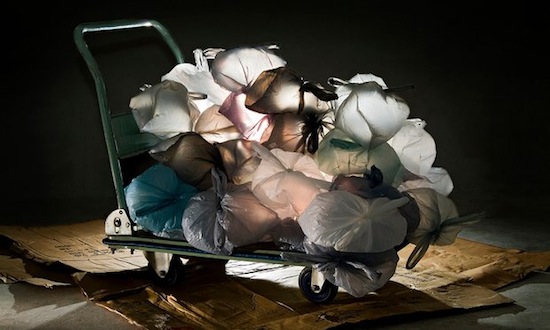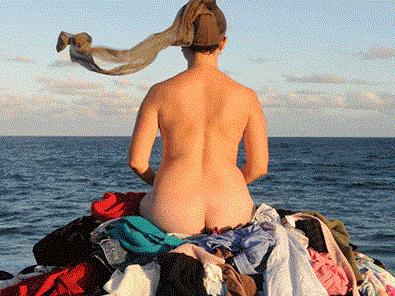Performance Production still of Katthy Cavaliere’s video nest (2010), as featured in a new retrospective of the Australian performance artist.
Katthy Cavaliere was loved. The title of her posthumous survey, curated by Sydney-based Daniel Mudie Cunningham, aptly captures that bittersweet tinge that love can bare.
In this case, the love for a mother – who Cavaliere lost just a few years prior to her own early death from the same ovarian cancer – and the love of an artist by a community. She was what we like to describe as “an artist’s artist”, unwaivering in her integrity to her work.
Cunningham was a close friend of Cavaliere’s and one can’t help but tap into that sensitivity and sincerity viewing this exhibition, which traces thirteen years of Cavaliere’s life and making. Simply, for her, the two were intertwined.
While for Cavaliere this was a very emotional and cathartic unpacking and re-packaging of her personal trauma, for the viewer, however, one is caught between voyeurism and our own sense of nostalgia, witness to a kind of eerie exorcism.
Hobart’s Museum of Old and New Art (Mona) could then be thought of as the natural venue for this retrospective, playing off collector David Walsh’s fascination with the spiritual, the macabre and life-less. There is also a further connection. The same gallery was used recently by Marina Abramovic to connect through objects, an artist who Cavaliere was mentored by early in her career.
That feeling of ghosting remained strong across this exhibition.
It felt totally normal to walk up stairs to a viewing platform and peer down into an oversized box that contained Katthy’s childhood room, blurring the familiar with a peepshow quality; the body and the residual equal in their potency. And yet, the objects – a record player, dolls and a diary – offered triggers that bring us individually into this story.

Katthy’s Room (1998); Courtesy the artist’s estate, Collection of Mona
The installation was a recreation of Katthy’s Room (1998) presented at Artspace and described at the time as a “time capsule” from her family home in suburban Sydney. Cavaliere occupied the box-room for two hours every day during its original showing.
The works in Loved are presented in intimate spaces, tightly clustered with a kind of Cavaliere horror vacui in the Library Gallery, while spot installations surprise across levels of Mona’s Round House.
They have the presence of props from a stage set dramatically lit, but the theatrics have been distilled to a vulnerable realism, the objects plain as day.
Often we catch glimpses of the artist, hear her voice or breath, or brush her memories as we pass. We almost feel like she is caught in the space between these works.
Her diaries read: ‘My mother, a naïve woman, fell pregnant to my father the first time she made love – she was a virgin – I was a mistake…I had a traumatic birth – forced out by a doctor who was in a hurray to go shopping and buy shoes. I often get stuck in life and call for someone to get me out – I get stuck in thoughts or spaces which I feel like I can’t get out of.’ (1999)
We are permitted to occupy those eddies of Cavaliere’s personal space in this exhibition intensified by its overhang, which has an uncanny quality of drawing out our own sense of disorientation.
Nicole Durling, Mona Co-Director of Exhibitions says of the work: ‘There is a remarkable honesty to her work where, almost shamelessly, she laid her soul bare. Yet there is no glimpse of narcissism in the work; it retains an innocence and a vulnerability.’
One can only agree.
On the end wall in the main gallery bodiless-stockings create a backdrop, flacid with memory. They are part of the installation empty stockings: full of love (2010), which sits as a flotilla of memories – piles of clothing, shredded phone books and electricity bills, an hourglass holding her mother’s ashes, and a scarecrow-like protector over this parade.
It is her lament to her mother’s love in a very public, yet private, process of grieving.

Cavaliere’s installation at Mona empty stockings: full of love (2010); Courtesy the artist’s estate, photo ArtsHub
Opposite on a column is the poignant video, nest (2010) (pictured top), where Cavaliere wears a pair of her mother’s tights on her head fluttering like a windsock searching for direction, while sitting on a pile of Mara’s clothes gazing out to the ocean – a favoured outing they shared.
To the right sits a coffin-like cardboard box. We are instantly aware of its bodily scale. Inside it and spewing over uncontrollably are paper bags purportedly inflated by Cavaliere’s own breath.

Brown paper (2001) (pictured above) is set against a lightbox photograph of an industrial cart filled with discarded plastic shopping bags blown-up as soft balloons in Untitled home (2007). If anything light was sculpting them, giving them a presence.
Cavaliere was always negotiating her possessions – packing them, moving them, revisiting them just as a homeless person might cart their ‘world’ with them. There is an honour and a poetics to that, void of criticism or judgement.

Untitled home (2007); Courtesy of the artist’s estate, Collection of Artbank.
The mediums across her practice were weighted equally, indiscriminately sliding from one to the other – performance, installation, photography, video.
Despite training as a photographer, hers was a life lived, and performed, through objects. They were the nuances of daily life that gave her world meaning, and sometimes offered an anchor.
Cunningham has said that her parents were always filming her with a Super 8 camera, and that ‘obsession’ naturally transitioned into her own compulsion to document her life.
Cunningham captures that obsession in the intensity of his hang for this show, but also allows the viewer to start to feel the cyclical conversations; the sheer volume of headspace they occupied for Cavaliere.
He explained: ‘As much as her name was a typo, Katthy was an artist who considered the mistakes, accidents and emptiness of existence, what she called “reality’s black tunnel of nothingness”, as an imaginary space of wonder capable of suspending art and life.’
Did she feel an ominous cloud of early death? We will never know.
Perhaps a good metaphor is the image of the artist as a tap-dancing rag doll in a rubbish tip. It was the video piece Loved (2008) that Cavaliere thought was her career high point. First presented for Artspace’s 25th anniversary, it was later curated into an exhibition for the Italian Institute of Culture at the 2011 Venice Biennale.
Cavaliere died at just 40 (in 2012) after a six-month battle with cancer. Her creative energy, which Cunningham captures in this exhibition, however leaves Australian art history with a lasting legacy.
Simply, Cunningham – taking Cavaliere’s cue – has done a superb job at packaging up the past and ensuring its life in the present.
Rating 4 out of 5 Stars
Katthy Cavaliere: Loved
Museum of Old and New Art (Mona), Hobart.
28 November – 28 March 2016
It will be presented at Carriageworks, Sydney from 5 August – 11 September.
A major monograph opublished by her estate in association with Mona will be released late March.
www.mona.net.au




